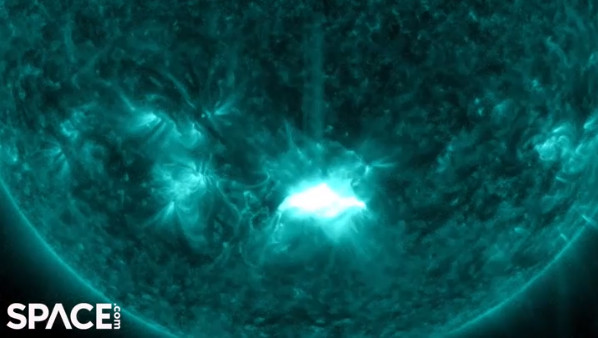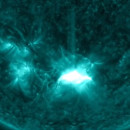Sun fires off major solar flare from Earth-facing sunspot
Space.com
October 28, 2021
Solar particles blasted out in association with the flare could hit Earth tomorrow (October 29).
A major solar flare erupted from the sun on Thursday (Oct. 28) in the strongest storm yet of our star's current weather cycle.
The sun fired off an X1-class solar flare, its most powerful kind of flare, that peaked at 11:35 a.m. EDT (1535 GMT), according to an alert from the U.S. Space Weather Prediction Center (SWPC), which tracks space weather events.
The flare caused a temporary, but strong, radio blackout across the sunlit side of Earth centered on South America, the group wrote in an statement. NASA officials called the solar eruption a "significant solar flare," adding that it was captured in real-time video by the space agency's Solar Dynamics Observatory.
A coronal mass ejection from the flare, a huge eruption of charged particles, could reach Earth by Saturday or Sunday (Oct. 30-31), just in time for Halloween, SpaceWeather.com reported. The eruption could supercharge Earth's northern lights and potentially interfere with satellite-based communications.
"POW! The sun just served up a powerful flare," NASA officials wrote on Twitter alongside a photo of the flare.
Solar flares are massive eruptions of radiation from the sun that send charged particles streaming outward from the star. Flares are classified in a letter system, with C-class storms being relatively week, M-class more moderate and X-class flares as the strongest.
"X-class denotes the most intense flares, while the number provides more information about its strength," NASA officials explained in a statement. "An X2 is twice as intense as an X1, an X3 is three times as intense, etc. Flares that are classified X10 or stronger are considered unusually intense."
When they are aimed directly at Earth, the most powerful X-class flares can interfere with radio and satellite communications and supercharge the planet's aurora displays. They can also be accompanied by a massive eruption of solar particles, called a coronal mass ejection. Such eruptions send charged particles out from the sun at a whopping 1 million mph (1.6 million kph) or more, and typically take a few days to reach Earth.
Thursday's flare appeared to also spawn a coronal mass ejection, SWPC officials said.
Thursday's flare originated from a sunspot called AR2887 currently positioned in the center of the sun and facing the Earth, based on its location. The sunspot was responsible for two moderate M-class solar flares earlier in the day, according to SpaceWeather.com, which also tracks daily sun weather.
The coronal mass ejection from a Tuesday flare up of AR2887 could deliver a "glancing blow" to Earth sometime on Friday (Oct. 30), SpaceWeather.com reported.
A new active sunspot, called AR2891, also recently fired off an M-class flare as it rotated toward the Earth-facing side of the sun. It is currently making its way across the face of the sun, as seen from Earth, a process that will take about two weeks.
The sun is in the early days of its current solar activity cycle, each of which lasts 11 years. The current cycle, called solar cycle 25, began in December 2019.





 Share your thoughts in the Forum
Share your thoughts in the Forum